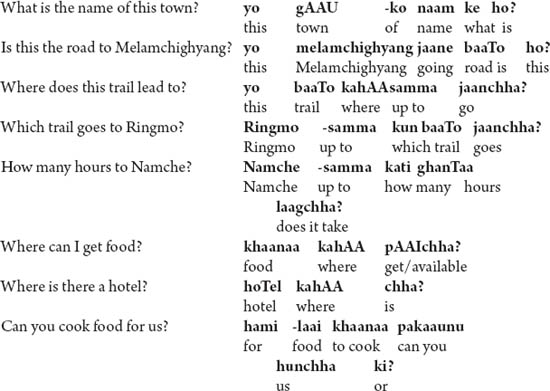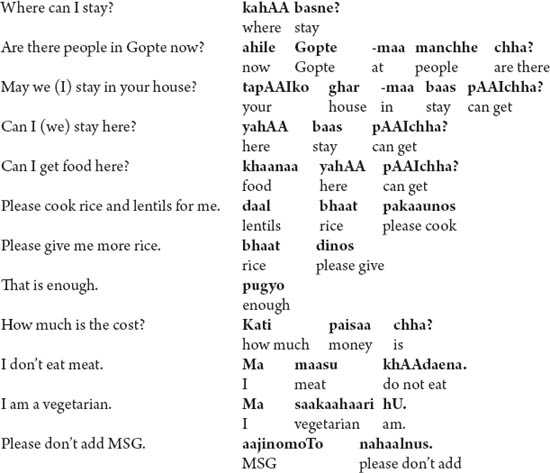
Nepali is an Indo-European language derived from Sanskrit. It is also one of India’s official languages and is relatively easy to learn.
In what follows, the transliteration system used for Nepali words in this book is described, with a pronunciation guide to enable the reader to pronounce place-names and other words correctly. A few important phrases are given.
Nepali is written in Devanagari script (as are Hindi and Sanskrit), but a system of transliteration to the Roman script is used here. Many of the letters denote their usual sounds, and only the special sounds are described.
The stress usually falls on the first syllable (chaá mal) unless the first syllable has a short vowel and is followed in the second syllable by a long one. Then the stress falls on the second syllable (pa kaaú nos). The single most common pronunciation error made by the beginning student is not putting the emphasis on the first syllable.
a |
like the a in balloon. Never like the a in hat. |
aa |
long like the a in father or car. |
i |
like ee in beer, the short and long forms pronounced similarly. |
u |
like oo in mood or root, again with the long and short forms similar. Never like the u in mute. |
e |
like a in skate or like the French e in café. |
ai |
a diphthong with the first element like the a in arise and the second like the y in city. Together, somewhat like the ay in laying, but not like the sound of the word eye. |
au |
a diphthong in which the first element is like the a in arise and the second like the u in put. |
o |
like o in bowl or go. |
aau, aai, and eu |
not diphthongs, but vowels pronounced separately one after the other. |
Capitalized vowels (A, E, I, O, U) indicate nasalization of that sound. Squeeze your nostrils together and force the sound to be made high up in the mouth.
With retroflexed consonants, make the sound farther back in the mouth, compared to the dental, which are made much more forward.
t |
pronounced unaspirated, with the tip of the tongue on the teeth as in the French petite. |
T |
like the t in little, with the tongue slightly bent back when it meets the roof of the mouth. |
d |
dental like the French d, in which the blade of the tongue is pressed behind the upper teeth. |
D |
pronounced with retroflexion of the tongue. Turn the tongue back in the mouth, press the underside of it against the palate, and pronounce the d in dog. |
R |
also pronounced with retroflexion of the tongue. |
Nepalis differentiate between aspirated and unaspirated consonants. This is quite difficult for native English speakers. Aspiration is indicated by an h following the consonant. Consciously avoid breathing hard or aspirating on the consonants that are not followed by an h.
The exception to the preceding rule in the transliteration scheme employed in this book applies to ch and chh. Only the latter is aspirated.
chh |
press the blade of the tongue behind the upper teeth and try to say ts. At the same time, exert strong breath pressure so that when the tongue is released from the teeth, there is a loud emission of breath. Listen to a native Nepali speaker. It is like the tch-h in pitch here. |
ch |
the unaspirated form as in chalk, Chinese. |
k |
like c in cat. |
y |
like y in yeast. |
s |
like s in song. |
j |
press the blade of the tongue against the upper teeth with the tip of the tongue pointed down and say j as in January. It is somewhat like dz and is especially found in words coming from Tibetan dialects. |
ph |
like f in full. |
p |
less aspiration than ph (more like p than f). |
Other consonants should present little difficulty. When two consonants come together, be sure to pronounce them individually.
The basic form is to inflect at the end of the sentence; that is, raise the pitch of your voice on the ending word.
The following is a brief introduction to asking the way as you walk along trails, together with other essential phrases. Trekkers are advised to use other resources for further language study. The spacing for the gloss of the Nepali phrases may help you change the phrases to suit your needs as you gain facility with the language.

